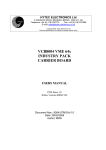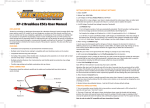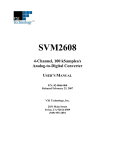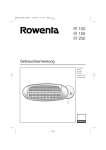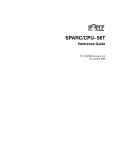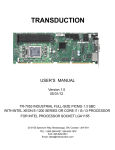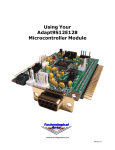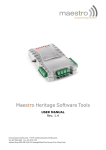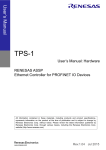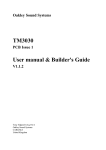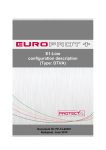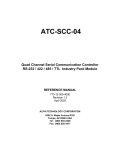Download User Manual - Hytec Electronics Ltd
Transcript
HYTEC ELECTRONICS Ltd HEAD OFFICE: 5 CRADOCK ROAD, READING, BERKS. RG2 0JT, UK Telephone: +44 (0) 118 9757770 Fax: +44 (0)118 9757566 E-mail: [email protected] VICB8003 VME 64x INDUSTRY PACK CARRIER BOARD WITH SHARC DSP PROCESSOR. USERS MANUAL PCB Issue 3 Xilinx Version 8003V603 Document Nos.: 8003/UTM/A/x/3.0 Date: 26/11/2004 Author: PJM Hytec Electronics Ltd 8003/UTM/A/2/3.0 CONTENTS 1. PRODUCT DESCRIPTION...............................................................................................................................3 1.1 KEY FEATURES ..................................................................................................................................................4 2. USE OF THE VME DATA BUS AND MEMORY ACCESS..........................................................................5 2.1 VME ADDRESSING ............................................................................................................................................5 2.1.1 Short Addressing (A16 AM29h and 2Dh).................................................................................................5 ADDRESS MODIFIERS...................................................................................................................................................6 2.1.2 Standard Addressing (A24 AM39h and 3Dh)...........................................................................................6 2.1.3 Carrier board Configuration ROM (A24 AM2Fh)..................................................................................6 2.2 IP MEMORY ACCESS ..........................................................................................................................................6 2.2.1 IP Memory Size.........................................................................................................................................6 2.2.2 Carrier Board Memory Map ....................................................................................................................7 ADDRESS MODIFIERS ..................................................................................................................................................7 3. ON BOARD FEATURES ...................................................................................................................................7 3.1 IP STATUS REGISTER (READ ONLY) ..................................................................................................................7 3.2 MEMORY OFFSET (READ/WRITE)......................................................................................................................7 3.3 CONTROL & STATUS REGISTER CARRIER BOARD (CSR CB) .............................................................................8 3.4 IP INTERRUPT SELECT REGISTER (READ/WRITE) ..............................................................................................8 3.5 VME SYSTEM AND BOARD RESETS ...................................................................................................................8 3.5.1 A VME system reset will clear the following registers:............................................................................8 3.5.2 A board reset generated from the CSR CB bit 0 will clear the following registers: ...............................8 4. INTERRUPT SETTINGS...................................................................................................................................9 5. VME64X KEYING AND ALIGNMENT PINS ................................................................................................9 6. SHARC PROCESSOR AND ASSOCIATED DEVICES ............................................................................ 10 6.1 Configurations available 6.2 SHARC Control Registers 6.2.1 IP Status Register 6.2.2 Memory Offset Register 6.2.3 Control and Status Register SHARC (CSR_SH) 6.2.4 IP Interrupt Select Register 6.3 SHARC Memory Addressing 6.4 Operating Principles 6.5 Connector Pin Definitions APPENDIX A PCB JUMPERS.............................................................................................................................16 APPENDIX B CARRIER BOARD CONFIGURATION ROM .........................................................................17 APPENDIX C ID PROM REGISTERS (GREENSPRING FORMAT) ................................................................18 PRODUCT SPECIFICATIONS ...............................................................................................................................19 VME64X PIN ASSIGNMENTS................................................................................................................................20 Page 2 of 21 Hytec Electronics Ltd 8003/UTM/A/3/3.0 1. PRODUCT DESCRIPTION The VICB 8003 is a 6U (double height) VME board constructed to the VME64x standard, with EMC front panel, injector/ejector handles, guide pin and slot keying, static discharge protection, hot swap capability, blue power up LED, geographical addressing or jumpers, 5-row P1 and P2 connectors and 5-row P0 connector. An Analog Devices ADSP21061 or 21062 SHARC (Super Harvard Architecture) DSP processor is also fitted for front-end processing. The module features hot-swap capability with auto power up and host interaction. An on-board FPGA allows full mapping of the IP board memory, I/O and ID spaces. The VME interface supports short I/O access A16:D32:D16:D08 (EO), standard I/O access A24:D32:D16:D08 (EO) and extended memory access A32:D32:D16:D08 (EO). Four Industry Pack sites are available and can accept 4 single-size Industry Packs. The carrier board supports the 8MHz IP interface. One of VMEbus interrupt lines IRQ1 to IRQ7 can be selected and enabled by writing to an on-board register. The Industry Pack interrupt lines INT0 and INT1 from each of the four sites can be enabled on an individual basis and mapped to the selected VME IRQ line. The base address of extended memory can be set by register (offset addressing) or by geographical addressing lines. The size of the IP memory allocated to each site can be set to 1MB, 2MB, 4MB or 8MB per site through a control register. Four front panel mounted LED’s flash to visually confirm completed IP access cycles to individual slots. There is a TTL input on the front panel that allows connection to any or all of the IP card Strobe lines through jumpers. The signal is routed through a reserved pin on the IP logic connector to allow overall control to be applied to IP boards in data acquisition systems. The carrier board has some thickened I/O tracks to allow the IP boards to be powered externally to give full isolation. All I/O is via the VME backplane P0 and P2 connectors as specified in the VME64 extensions specification. The signals connect to the industry pack sites according to the VME64x Greenspring pinout for IP module carriers. Hytec has a number of rear-mounted transition cards with high-density 50-way [SCSI2] connectors, which can cater for all 200 IP I/O signals and provide any necessary signal conditioning. Page 3 of 21 Hytec Electronics Ltd 8003/UTM/A/4/3.0 1.1 Key Features • VME64 extensions / Industry Pack Carrier Board • VME64x rear panel I/O • ADPS21061 or 21062 SHARC DSP microprocessor with Flash boot EPROM and optional RAM memory and front panel serial or LVDS link ports. • Full EMC shielding and insertion/extraction handles • Fully Hot-Swap capable with auto power-up and host interaction • 6U (double height) VME base card • User selectable VME interrupt level • Geographical addressing • Front panel TTL input to IP cards via Strobe lines • Thickened I/O lines to allow external power supplies to IPs • VME 64x Configuration ROM • On-board clock generation • VME64x guide pin and slot keying • 3.3V supply to P2 connector • 5V supply to P2 connector Page 4 of 21 Hytec Electronics Ltd 8003/UTM/A/5/3.0 2. USE OF THE VME DATA BUS AND MEMORY ACCESS 2.1 VME Addressing The module uses A16/D32/D16/D08 (EO) (Even and Odd byte) or A24/D32/D16/D08 (EO) for accesses to the IP I/O, IP ID and Carrier board Configuration Registers. The base address of these areas is determined either by PCB jumper settings (J6 to J10) or by VME64x geographical addressing lines GA0 to GA4. The PCB jumpers on issue 2 boards should be used only where geographical addressing is not available and will override the GA lines so they should not be fitted in a GA crate. Later issue 3 PCBs have a different jumper arrangement where either jumpers or GA lines set the base address. (see appendix A) Address I/O Base+ Offset 0x0000 I/O Base+ 0x0080 I/O Base+ 0x0100 I/O Base+ 0x0180 I/O Base+ 0x0200 I/O Base+ 0x0280 I/O Base+ 0x0300 I/O Base+ 0x0380 I/O Base+ 0x0400 I/O Base + 0x0420 I/O Base + 0x0440 I/O Base+ 0x0480 I/O Base+ 0x0600 Range Assignment 0x0000 IP A I/O Space 0x007E 0x0080 IP A ID Space 0x00FE 0x0100 IP B I/O Space 0x017E 0x0180 IP B ID Space 0x01FE 0x0200 IP C I/O Space 0x027E 0x0280 IP C ID Space 0x02FE 0x0300 IP D I/O Space 0x037E 0x0380 IP D ID Space 0x03FE 0x0400 Carrier on board registers 0x041E 0x0420 SHARC Control Registers 0x043E 0x0440 Dual-Ported SRAM accessible 0x047E from VME and SHARC 0x0480 Green Springs Type ID 0x04FF 0x0600 VME64x configuration ROM 0x07FF (See appendix B) 8003 A16 and A24 address Map Size 128 Bytes 128 Bytes 128 Bytes 128 Bytes 128 Bytes 128 Bytes 128 Bytes 128 Bytes 32 Bytes 32 Bytes 64 Bytes 128 Bytes 512 Bytes 2.1.1 Short Addressing (A16 AM29h and 2Dh) In Short address mode the geographical addressing lines equate to the address lines GA0 =A11 to GA4=A15 and the jumper address setting J6=A11 to J10=A15. A11 - A15 is the module address determined by the setting of the relevant PCB jumpers or geographical address lines Address modifiers IP I/O, IP ID and Carrier board Configuration Registers: AM29 Short (A16) non-privileged. AM2D Short (A16) supervisory. Page 5 of 21 Hytec Electronics Ltd 8003/UTM/A/6/3.0 2.1.2 Standard Addressing (A24 AM39h and 3Dh) The A24 base address is determined either by PCB jumper settings J6=A19 to J10=A23 or by geographical addressing lines GA0 =A19 to GA4=A23. IP I/O, IP ID and Carrier board Configuration Registers: AM39 Standard (A24) non-privileged. AM3D Standard (A24) supervisory. 2.1.3 Carrier board Configuration ROM (A24 AM2Fh) See appendix B for the contents of the configuration ROM. Address modifiers AM2F Configuration ROM/Control & Status Registers. Address selection as above. 2.2 IP Memory Access The module uses A32/D16/D08 (EO) (Even and Odd byte) for accesses to the IP memory. The base address of the memory can be set by either the Geographical address lines/jumpers or by using the Memory Offset Register. Writing a ‘1’ to bit 6 of the CSR CB register (base + 0x0408h) selects the Memory Offset Register to set the base address. MEM MODE (bit 6 CSRCB) 0 1 Memory Addressing Mode Geographical address lines Memory Offset register Bit 6 CSR CB setting the memory address mode Using the Memory Offset Register allows address lines A22 to A31 to be used to set the base address. Geographical addressing uses the lines GA0=A22 to GA4=A26 – see table below. 2.2.1 IP Memory Size Some controllers have a limited memory range so to take account of this when using geographical addressing the memory size allocated to each IP card can be controlled: CSR CB IPMS1 IPMS0 (bit 8) (bit 7) 0 0 0 1 1 0 1 1 IP Memory Size 1MB 2MB 4MB 8MB Address Lines Geographical Memory Offset Addressing Register A22-A26 ** A22-A31 A23-A26 ** A23-A31 N/A A24-A31 A27-A31 A25-A31 Here the GA address is shifted up one. This only allows 16 slots to be used with geographical Addressing NOTE ** Upper address lines A27-A31 inclusive MUST all be zero in this mode. Page 6 of 21 Hytec Electronics Ltd 8003/UTM/A/7/3.0 2.2.2 Carrier Board Memory Map Memory Range Address 1MB 2MB 4MB Memory Base + 0x000000 0x000000 0x000000 0x0FFFFE 0x1FFFFE 0x3FFFFE Memory Base + 0x100000 0x200000 0x400000 0x1FFFFE 0x3FFFFE 0x7FFFFE Memory Base + 0x200000 0x400000 0x800000 0x2FFFFE 0x5FFFFE 0xBFFFFE Memory Base + 0x300000 0x600000 0xC00000 0x3FFFFE 0x7FFFFE 0xFFFFFE Address Modifiers Memory: Memory Assignment 8MB 0x000000 0x7FFFFE 0x800000 0XFFFFFE 0x1000000 0x17FFFFE 0x1800000 0x1FFFFFE IP A IP B IP C IP D AM09 or AM0D (extended non-privileged or supervisory) 3. ON BOARD FEATURES The configuration and control of the 8003 module is achieved by the following registers: Base Base + Base + Base + Base + Offset 0x400 0x404 0x408 0x40C 3.1 IP Status Register (Read Only) Address: D15 Register Description IP Status Allows state of IP INT and Error flags to be monitored Memory Offset Sets base address of IP memory areas Control & Status Register CB Set up of VME part of 8003 IP Interrupt Select Selects IP interrupts to be mapped to VME IRQ 8003 On-Board Registers D14 Read = Base + 0x0400 D13 D12 IP TIME OUT D11 ERR D D10 ERR C D09 ERR B D08 ERR A D07 INT REQ D1 D06 INT REQ C1 D05 INT REQ B1 D04 INT REQ A1 D03 INT REQ D0 D02 INT REQ C0 D01 INT REQ B0 D00 INT REQ A0 Two interrupt status and one error status bits for each of IP sites A – D plus the SHARC IP Timeout flag bit (see section 6.2.1). 3.2 Memory Offset (Read/Write) Address: Read = Base + 0x0404, Write = Base + 0x0404 D15 A31 D14 A30 D13 A29 D12 A28 D11 A27 D10 A26 D09 A25 D08 A24 D07 A23 D06 A22 D05 x ‘x’ = don’t care Page 7 of 21 D04 x D03 x D02 x D01 x D00 x Hytec Electronics Ltd 8003/UTM/A/8/3.0 3.3 Control & Status Register Carrier Board (CSR CB) Control (Write) Address: Base + 0x0408 D15 D14 D13 D12 D11 D10 D09 D08 D07 NU NU NU NU NU NU NU IP MS1 IP BADD IPCLK INTSEL INTSEL INTSEL INTEN Rst MS0 SEL SEL 2 1 0 D06 D05 D04 D03 D02 D01 D00 D10 NU D09 D08 D07 D06 D05 D04 D03 D02 D01 D00 NU IPMS IPMS BADD IPCLK INTSEL INTSEL INTSEL INTEN Rst 1 0 SEL SEL 2 1 0 Status (Read) Address: Base + 0x0408 D15 NU D14 NU Rst INTEN INTSEL0 INTSEL1 INTSEL2 IPCLKSEL BADDSEL IP MS0 IP MS1 D13 NU D12 NU D11 NU Clears status register to zero when written as a ‘1’. Enable interrupt from carrier board to VMEbus backplane. Select VME interrupt level. Select VME interrupt level. (See section 4). Select VME interrupt level. Select 8MHz IP clock =0 or 32MHz clock =1. Select memory base address to be defined by geographical address lines=0 or by Memory offset register=1. Set IP memory size. Set IP memory size. (See section 2.2) 3.4 IP Interrupt Select Register (Read/Write) Address: Base + 0x040C D15 NU D14 NU D13 NU D12 NU D11 NU D10 NU D09 NU D08 NU D07 D06 D05 D04 D03 D02 D01 D00 IPINT IPINT IPINT IPINT IPINT IPINT IPINT IPINT D0 C0 D1 C1 B1 A1 B0 A0 This selects which IP interrupt lines will be enabled. ‘1’ = corresponding IP card interrupt enabled. 3.5 VME System and Board Resets 3.5.1 A VME system reset will clear the following registers: • • • CSR CB Memory Offset Register IP Interrupt Select register 3.5.2 A board reset generated from the CSR CB bit 0 will clear the following registers: • • CSR CB IP Interrupt Select register Page 8 of 21 Hytec Electronics Ltd 8003/UTM/A/9/3.0 4. INTERRUPT SETTINGS The interrupt level generated by the carrier board is set using the CSR CB register INTSEL0 (bit 2), INTSEL1 (bit 3), and INTSEL2 (bit 4). Interrupt Level None IRQ 1 IRQ 2 IRQ 3 IRQ 4 IRQ 5 IRQ 6 IRQ 7 INTSEL 2 INTSEL 1 INTSEL 0 0 0 0 0 0 1 0 1 0 0 1 1 1 0 0 1 0 1 1 1 0 1 1 1 VME Interrupt Level Select The IP Interrupt Select register allows the user to enable only the IP interrupts required and mask off the rest. To select an IP interrupt write a ‘1’ to the appropriate bit of the register see section 3.4 above. The interrupt vector is held on the individual IP cards. To enable VME interrupts from the carrier board to the VMEbus backplane set bit 1 of the CSR CB to ‘1’. Writing a ‘0’ to this register disables the interrupts. The VME interrupt is cleared when it is acknowledged [ROAK protocol]. The IP interrupts are prioritised in the 8003 where IP A has the highest and IP D the lowest. Each IP card can be loaded with a separate IP vector and when an interrupt occurs the controller will be given the interrupt vector of the highest priority IP card currently asserting either of its interrupt lines. If all four cards interrupt at the same time then IP A will be serviced first then IP B then IP C and finally IP D. Reading the IP Status register of the 8003 at base + 0x0400 (READ ONLY) shows which IP cards have interrupts pending. 5. VME64x KEYING AND ALIGNMENT PINS The keying mechanism provides for three key holes on top and three keying holes on the bottom of each board and subrack slot. Each key hole can be keyed with a “No Key” or a keying peg in one of four positions. With three key holes top and bottom the scheme provides a total of 15,625 keying combinations. Page 9 of 21 Hytec Electronics Ltd 6. 8003/UTM/A/10/3.0 SHARC PROCESSOR AND ASSOCIATED DEVICES 6.1 Configurations available The 8003 board is available in a number of versions with different processors and peripherals as follows: Model Number Processor 8003.0 8003.1 8003.2 Additional features ADSP21061 ADSP21062 ADSP21061 None None Second Flash EPROM, 256K x 32 SRAM, PC16550 RS232 serial port and two SHARC serial links on front-panel micro-D connectors. ADSP21062 Six front-panel LVDS SHARC links on micro-D connectors. 8003.3 All units are fitted with one 1M x 8 flash EPROM boot device. This flash EPROM plus the processor’s internal RAM and the second flash EPROM and external RAM if fitted, are all accessible from VME on a write/read basis unless J22, the write protect jumper, is fitted. Two jumpers, J13 and J14, are used to select the boot mode of the processor as follows: J13 OUT OUT IN IN J14 OUT IN OUT IN Mode selected HOST-controlled mode, boot from Host (host writes program directly into SHARC). HOST-controlled mode, boot from Link Port. Stand-Alone mode, boot from Flash 0. (default) Stand-Alone mode, boot from Flash 1. (PC16550 Remote serial connect). 6.2 SHARC Control Registers The ADSP21061/2 has its own set of registers in the Xilinx through which its operation is controlled either by VME or the 21061/2. The set is positioned as shown in the table in Section 2.1 and comprises the following: Base Base + Base + Base + Base + Offset 0x420 0x424 0x428 0x42C 6.2.1 IP Status Register (R/W) Address: D15 Register Description IP Status Allows state of IP INT and Error flags to be monitored SHARC Memory Offset Sets base address of SHARC memory areas in VME A32 Control & Status Register SH Set up of SHARC part of 8003 IP Interrupt Select Selects IP interrupts to be mapped to SHARC IRQ 8003 SHARC Registers D14 Read = Base + 0x0420 D13 D12 D11 SHARC ERR IP D ERROR D10 ERR C D09 ERR B D08 ERR A D07 INT REQ D1 D06 INT REQ C1 D05 INT REQ B1 D04 INT REQ A1 D03 INT REQ D0 D02 INT REQ C0 D01 INT REQ B0 D00 INT REQ A0 Two interrupt status and one error status bits for each of IP sites A – D. Plus a flag bit, bit 12, indicating a failure when the SHARC attempted an IP access. Any write to offset 0x420 clears this bit. Page 10 of 21 Hytec Electronics Ltd 8003/UTM/A/11/3.0 6.2.2 Memory Offset (Read/Write) Address: Read = Base + 0x0424, Write = Base + 0x0424 D15 A31 D14 A30 D13 A29 D12 A28 D11 A27 D10 A26 D09 A25 D08 A24 D07 A23 D06 x D05 x D04 x D03 x D02 x D01 x D00 x ‘x’ = don’t care 6.2.3 Control & Status Register SHARC (CSR SH) Address: Base + 0x0428 D15 D14 D13 D12 D11 FLAG FLAG FLAG FLAG OE3 2 1 0 F2/3 D10 D09 D08 D07 D06 OE- SYSR IPMS IPMS X F0/1 ST 1 0 D05 D04 D03 D02 J22 IRQ1 IRQ0 J14 D01 J13 D00 RST RST: Reset the SHARC processor (pulse on write ‘1’) reads ‘1’ for SHARC RUN enable. J13/14 State of start-up jumpers, read only (RO): jumper OUT = ‘1’. IRQ0 ‘1’ = map selected IP interrupts to SHARC IRQ0. (R/W) IRQ1 ‘1’ = map selected IP interrupts to SHARC IRQ1. (R/W) [Select only one of these!]. J22 State of the write protect jumper, read only (RO): jumper OUT = ‘1’ = Write Enabled. IPMS0, 1 Reflects state of IP memory size selection from CSRCB. (RO). SYSRST ‘1’ = Permit VME SYSRST to reset SHARC processor. (R/W). OE-F0/1 Output enable for Flag0 and Flag1 outputs. OE-F2/3 Output enable for Flag2 and Flag3 outputs. Flag0 Writeable bit which, if enabled, will drive the SHARC Flag0 pin. Reads actual state. Flag1 Writeable bit which, if enabled, will drive the SHARC Flag1 pin. Reads actual state. Flag2 Writeable bit which, if enabled, will drive the SHARC Flag2 pin. Reads actual state. Flag3 Writeable bit which, if enabled, will drive the SHARC Flag3 pin. Reads actual state. 6.2.4 IP Interrupt Select Register (Read/Write) Address: Base + 0x042C D15 NU D14 NU D13 D12 NU SHARC IP ERROR D11 NU D10 NU D09 NU D08 NU D07 D06 D05 D04 D03 D02 D01 D00 IPINT IPINT IPINT IPINT IPINT IPINT IPINT IPINT D0 C0 D1 C1 B1 A1 B0 A0 This selects which IP interrupt lines will be mapped to the SHARC IRQ line selected in CSR SH. Note that it would be incorrect to map an IP interrupt to both VME and SHARC. It also allows the SHARC IP ERROR bit to be mapped to the SHARC IRQ. ‘1’ = corresponding IP card interrupt enabled. 6.3 SHARC Memory Addressing The internal RAM of the SHARC processor and its peripherals, the flash EPROM(s) and external RAM are all accessible from VME through offset addressing. The offset is specified in the register described in section 6.2.2. Page 11 of 21 Hytec Electronics Ltd 8003/UTM/A/12/3.0 Note also that the way that the SHARC processor addresses memory is quite different from that used in VME. That is, whatever the size of the addressed object, the address increment is always 1. Thus consecutive bytes of the flash EPROM as seen from the SHARC are at addresses 00000000, 00000001 and 00000002 and consecutive 32-bit data words in its memory or the external data memory are likewise addressed at 0xx00000, 0xx00001 and 0xx00002, where ‘xx’ represents upper address bits to select the appropriate area of memory. In order to connect this strange arrangement to VME, the least significant address line of VME, namely A1, has been connected to the least significant SHARC address line. Thus consecutive bytes in a flash EPROM will appear as lower (D00-D07) bits in consecutive words of VME space. When composing write commands to the flash, it should be remembered that in order to produce a particular EPROM address, double that value needs to be placed on the VME address lines. [i.e. shift the address up one bit]. When consecutive 32-bit words of SHARC internal RAM or external RAM (if fitted) are addressed from VME in D32 mode (LWORD asserted), the VME address is further shifted down one bit in order to map these areas correctly and make them accessible to the host – see the address map below. If LWORD is not asserted (i.e.D16 mode) this address shift does not occur making SHARC internal memory ‘Short Word Addressing’ possible. 6.3.1 SHARC VME Memory Addressing Map. Offset from Register SHARC -set Base Address Address Contents 000000 -0003FC 000000-0000FF SHARC IOP Registers – D32 only 080000-08FFFC 020000-023FFF SHARC Internal RAM Block 0 - Normal Word Addressing - D32 090000-09FFFC 024000-027FFF SHARC Internal RAM Block 1 - Normal Word Addressing - D32 [32-bit long words on long word boundaries or 16-bit lower/upper words on word boundaries if SHARC Short Word Addressing is selected by NOT asserting LWORD – D16]. For example, D32 write/read 0x12345678 at offset 0x090000, then D16 read 0x5678 at offset 0x090000 and 0x1234 at offset 0x090002. 200000-3FFFFE MS0 or BMS Flash EPROM 0 [D0-7 bytes on word boundaries] 400000 -5FFFFE MS0 + 0x100000 Flash EPROM 1 (if fitted) [D0-7 bytes on word boundaries] 600000 -6FFFFC MS2 SHARC external RAM (if fitted) [256K x 32-bit long words on long-word boundaries: D32 only] 6.3.2 SHARC Address Map The way that the SHARC processor addresses external devices is on the basis of banks. Each bank has a chip select line associated with it and a register, which defines how cycles are completed. The four select lines are connected as follows: MS0 or BMS (Boot memory select) connects to flash memory 0 or 1 (chosen by the Xilinx). MS1 connects to the PC16550 UART device, if fitted. MS2 connects to the external RAM MS3 connects to the Xilinx for access to internal registers and the IP cards. All except MS3 should have their cycles completed internally by the wait state machine. The default value of 6 internal clocks (of the 32MHz master clock) is OK for all these devices. Cycles to the Xilinx (and to the IP cards through the Xilinx) should be terminated externally by ACK after an internal wait of 6 clocks. The actual access times of the external devices, if fitted, are as follows and the user may trim the wait state machine to these timings if desired: Flash EPROM:90 nanoseconds. SRAM: 20 nanoseconds Page 12 of 21 Hytec Electronics Ltd 8003/UTM/A/13/3.0 PC16550 UART: 150 nanoseconds approx. (use 6 wait states). SHARC Address Map: Address Range Contents 00000000-0007FFFF 00080000-003FFFFF 00400000-004FFFFF 00500000-005FFFFF 00600000-00BFFFFF 00C00000-013FFFFF 01400000-014FFFFF 01500000-01BFFFFF 01C00000-01C007FF 02000000-020FFFFF 02100000-021FFFFF 02200000-022FFFFF 02300000-023FFFFF SHARC Internal RAM SHARC multi-processor space (not used). Flash EPROM 0. Flash EPROM 1. Aliases of Flash EPROM’s 0 and 1. PC16550 UART Device – only a very small part used! 256K X 32-bits External RAM (if fitted). Aliases of external RAM. IP I/O and ID access plus Xilinx registers (as VME A16 map). IP ‘A’ Memory access (1M 16-bit words). IP ‘B’ Memory access. IP ‘C’ Memory access. IP ‘D’ Memory access. Thus each of MS0, 1, 2 and 3 MUST to be set up as 8M blocks. The Xilinx provides ACK termination for all accesses by MS3, whether the SHARC addresses internal registers, configuration data, dual-ported RAM or IP cards. It also provides termination even if the addressed device is not present (that is an absent or faulty IP card). 6.4 Operating Principles The normal procedure for operating the SHARC processor on this card is to develop a program for it, load it into the flash EPROM and then let it run. Some applications may require the program to be downloaded to the card over a serial line and then programmed into the flash by the SHARC processor. This requires a ‘secondary’ boot program, which is held in the optional second flash device as a ‘low level boot program’. Care should be exercised when down-loading a program to the SHARC since in certain modes it is looking constantly for the appearance of valid code in certain locations, for example in host-booted mode. For this reason it is recommended that the first word of code be written last. Internally, the 8003 has a shared address and data bus. There are two possible masters of this bus – the SHARC processor and the VME port (through the Xilinx). By default, the SHARC is bus master and the VME port requests use of the bus when it decodes a valid address and modifier. It does this by asserting host bus request (HBR) and receiving host bus grant (HBG). The time taken to achieve this will depend on what the SHARC is doing when the request arrives but there should be no more than a 1 microsecond delay. The SHARC experiences a similar ‘interruption’ if the VME port uses the bus. In order to be able to examine VME addresses while the SHARC is in control of the bus, the address lines are separated by a set of buffers. When the SHARC wishes to address the Xilinx-connected areas (that is the IP cards and Xilinx internal areas) or when the VME port wishes to access SHARC memory areas, the buffers are used to connect the address lines together. If the SHARC does access Xilinx-connected areas using MS3, this signal is used to inhibit the VME address-decoding scheme and turn off any VME buffers which would contend with the SHARC cycle. Page 13 of 21 Hytec Electronics Ltd 8003/UTM/A/14/3.0 It is important to bear in mind that if the SHARC processor attempts to address an area of memory which does not physically exist (that is outside the ranges shown in the above address map) then cycle termination will not take place and the processor will enter a ‘hung’ state. In the unlikely event that this should happen then a working program MUST replace the program that caused it to happen. The difficulty is that if the processor enters the ‘hung’ state then the usual mechanism for changing the program, writing to the flash from VME, will not work because it relies on the SHARC granting the bus to the VME port, which at this stage it is unable to do. Nor can the SHARC rectify the problem itself since it is unable to communicate with anything. The only exit from this ‘deadly embrace’ is to power the board off and select a different start-up mode such as booting from a link port. The processor will not find a program to run and enter a dormant state in which it is possible for you to re-program the flash with working code. 6.5 Connector Pin Definitions As described in Section 6.1, some of the variants of this board have front-panel connectors. The details of these are as follows: 8003.2: CON1 ‘RS232’ 9-way Micro-D Connector for the RS232 signals from the PC16550DV UART device. Pins 1, 2, 3, 4, 5: Pin 6: Pin 7: Pin 8: Pin 9: GND Clear to Send (CTS) Input Serial Data Input Serial Data Output Request to Send (RTS) Output. Note: The 16550 can be programmed to ignore the state of the CTS input. Connector part number: ITT Cannon MDSM-9PE-Z10-VR1; Electrospeed 17-0628K. Mating connector ITT Cannon MDSM-9SC-Z11-VS1; Electrospeed 17-0631F with crimp contacts MDS-S-H; Electrospeed 170634B.. CON3 ‘SSP0’ 15-way Micro-D Connector for the TTL signals from the SHARC Synchronous Serial Port 0. Pin 1: Pin 2: Pin 3: Pin 4: Pin 5: Pin 6: Pin 7: Pins 8-15 GND Transmit Data Output (DT0) Receive Data Input (DR0) Transmit Clock Output (TCLK0) Receive Clock Input (RCLK0) Transmit Frame Sync. Output (TFS0) Receive Frame Sync. Input (RFS0) No Connect. Connector part number: ITT Cannon MDSM-15PE-Z10-VR1; Electrospeed 17-0629E. Mating connector ITT Cannon MDSM-15SC-Z11-VS1; Electrospeed 17-0632A with crimp contacts MDS-S-H; Electrospeed 170634B. Page 14 of 21 Hytec Electronics Ltd 8003/UTM/A/15/3.0 CON4 ‘SSP1’ 15-way Micro-D Connector for the TTL signals from the SHARC Synchronous Serial Port 1. Pin 1: Pin 2: Pin 3: Pin 4: Pin 5: Pin 6: Pin 7: Pins 8-15 GND Transmit Data Output (DT1) Receive Data Input (DR1) Transmit Clock Output (TCLK1) Receive Clock Input (RCLK1) Transmit Frame Sync. Output (TFS1) Receive Frame Sync. Input (RFS1) No Connect. 8003.3: CON 2, CON3, CON4 Double-stacked 2 x 15-way Micro-D Connectors for the LVDS signals from SHARC Link Ports 0 and 1, 2 and 3 and 4 and 5 respectively. Each of the six connector parts has the same pinout as follows:Pin 1: Pin 9: Pin 2: Pin 10: Pin 3: Pin 11: Pin 4: Pin 12: Pin 5: Pin 13: Pin 6: Pin 14: Pin 7: Pin 8: Pin 15: GND Link Clock (-) Link Clock (+) Link Acknowledge (-) Link Acknowledge (+) Link Data Bit 2 (-) Link Data Bit 2 (+) Link Data Bit 3 (-) Link Data Bit 3 (+) Link Data Bit 0 (-) Link Data Bit 0 (+) Link Data Bit 1 (-) Link Data Bit 1 (+) VCC through a zero ohm resistor. No Connect. Connector part number: ITT Cannon MDSM-30PE-Z10-VR22; Electrospeed 17-54859D. Mating connectors (2 off required for each) ITT Cannon MDSM-15SC-Z11-VS1; Electrospeed 17-0632A with crimp contacts MDS-S-H; Electrospeed 17-0634B. Page 15 of 21 Hytec Electronics Ltd APPENDIX A 8003/UTM/A/16/3.0 PCB JUMPERS Hytec 8003 SHARC IP Carrier Board J1 J2 J3 J4 J5 J6 – J10 J6 J7 J8 J9 J10 J11 J12 J13, J14 J15 J16 J19 J17 J20 J18 J21 J22 Connects the common strobe line from the Xilinx to Industry Pack C Logic Connector pin 46. Must be IN Factory set. Connects the common strobe line from the Xilinx to Industry Pack A Logic Connector pin 46. Supplies switched and fused +5V to pins P2 A32 and P2 C32 (Delivered Not selected). Connects the common strobe line from the Xilinx to Industry Pack B Logic Connector pin 46. Base address setting: Used to select either Geographical Addressing or jumper setting. Make according to required A11-A15 base address as follows: Fitted AUTO A11 must match GA0 A12 must match GA1 A13 must match GA2 A14 must match GA3 A15 must match GA4 Fitted MANUAL A11 must be ‘0’ A12 must be ‘0’ A13 must be ‘0’ A14 must be ‘0’ A15 must be ‘0’ Not fitted A11 must be ‘1’ A12 must be ‘1’ A13 must be ‘1’ A14 must be ‘1’ A15 must be ‘1’ Connects the common strobe line from the Xilinx to Industry Pack D Logic Connector pin 46. Must be IN Factory set. Set the SHARC processor start-up mode. See section 6. SHARC JTAG test disable – should be fitted unless using the JTAG test port. LVDS SHARC Link Port 0 RX/TX select – link centre pin to either TX or RX. LVDS SHARC Link Port 1 RX/TX select – link centre pin to either TX or RX. LVDS SHARC Link Port 2 RX/TX select – link centre pin to either TX or RX. LVDS SHARC Link Port 3 RX/TX select – link centre pin to either TX or RX. LVDS SHARC Link Port 4 RX/TX select – link centre pin to either TX or RX. LVDS SHARC Link Port 5 RX/TX select – link centre pin to either TX or RX. Write protects SHARC memory areas from VME – IN = write protect. Note: The reference to the ‘Common Strobe Line’ refers to the front panel Inhibit signal which is passed through by the Xilinx unprocessed, thus asserting the Inhibit input low will drive all connected IP logic connector pins 46 low. Page 16 of 21 Hytec Electronics Ltd APPENDIX B 8003/UTM/A/17/3.0 Carrier Board Configuration ROM Address Offset 0x03 0x07 0x0B Value C1 00 02 00 0x0F Definition Check Sum Length of ID ROM MSB Length of ID ROM Length of ID ROM LSB Configuration ROM data access width 0x83 CSR data access width 0x83 CSR space Specification ID VME64x-1997 0x02 Identify a Valid CR ‘C’ 0x43 ‘R’ 0x52 Manufacturer’s ID 0x00 0x13 0x17 0x1B 0x1F 0x23 0x27 0x2B 0x2F 0x80 0x03 Board ID 0x33 0x37 0x3B 0x3F 0x80 0x03 0x00 0x00 0x43 0x47 0x4B 0x4F 0x03 0x06 0x00 0x03 Board build 0,1, 2 or 3. Revision ID PCB issue Xilinx version Xilinx revision nos Xilinx revision nos ASCII string null terminated or 0x000000 0x53 0x57 0x5B 0x00 0x00 0x00 Reserved for future use 0x5F to 0x7B Program ID code 0x7F 0x01 No program, ID ROM only Start of user defined area 0x80 Board Serial Number 0xCB, 0xCF, 0xD3 0xD7, 0xDB, 0xDF 0x 0x BEG_SN MSB END_SN LSB 0x123.. 0x13F 0x2200220000002200 AM code mask AM codes 3D, 39, 2D, 29, 0D, 09 Reading the Configuration ROM using A16 (AM29h and AM2Dh) or A24 (AM39h and AM3Dh) the address is VME base address + 0x0600h, the Configuration ROM offset. Page 17 of 21 Hytec Electronics Ltd 8003/UTM/A/18/3.0 APPENDIX C ID PROM Registers (GreenSpring Format) Address Offset 0x481 0x483 0x485 0x487 0x489 0x48B 0x48D 0x48F 0x491 0x493 0x495 0x487 Value 0x49 0x50 0x41 0x43 0x80 0x83 0x0x 0x00 0x00 0x00 0x0C Definition ASCII “I” ASCII “P” ASCII “A” ASCII “C” Manufacturer’s ID Model Number Revision Reserved Driver ID, low byte Driver ID, high byte No of bytes used CRC Page 18 of 21 Hytec Electronics Ltd 8003/UTM/A/19/3.0 PRODUCT SPECIFICATIONS Power Requirements +5V @ 600mA typical +12V @ 30mA -12V @ 30mA +3.3V @ approx 10mA Additional power maybe consumed by Industry Packs. Operating Temperature Range 0 to +45 deg Celsius ambient. Mechanical 6U single width VME module with access to 5 row P0, P1 and P2 connectors. IP Memory Mapping VME Access A32:D16:D8 (EO) AM Codes: 09h and 0Dh. IP I/O Mapping VME Access A16:D16:D8 (EO) AM Codes: 29h and 2Dh. VME Access A24:D16:D8 (EO) AM Codes: 39h and 3Dh. Front Panel Indicators and Inputs ‘VME’ LED (green) ‘Not Configured LED (blue) IP ACK 4 LED’s (red) Illuminates for a minimum of 20msecs whenever the module is accessed via the VME bus. Indicates the state of the VME module during hot swap operation. Indicate when an IP card has sent an ACK. Front Panel Inputs Inhibit Single TTL. This input has a 10K pull-up resister to 5Volt supply. Connector type: LEMO RA0302 Page 19 of 21 Hytec Electronics Ltd 8003/UTM/A/20/3.0 VME64x PIN ASSIGNMENTS ROW A P0.A01 P0.A02 P0.A03 P0.A04 P0.A05 P0.A06 P0.A07 P0.A08 P0.A09 P0.A10 P0.A11 P0.A12 P0.A13 P0.A14 P0.A15 P0.A16 P0.A17 P0.A18 P0.A19 SIG IODO1 IOD06 IOD11 IOD16 IOD21 IOD26 IOD31 IOD36 IOD41 IOD46 IOC01 IOC06 IOC11 IOC16 IOC21 IOC26 IOC31 IOC36 IOC41 ROW B P0.B01 P0.B02 P0.B03 P0.B04 P0.B05 P0.B06 P0.B07 P0.B08 P0.B09 P0.B10 P0 B11 P0.B12 P0.B13 P0.B14 P0.B15 P0.B16 P0.B17 P0.B18 P0.B19 SIG IOD02 IOD07 IOD12 IOD17 IOD22 IOD27 IOD32 IOD37 IOD42 IOD47 IO002 IO007 IO012 IO017 IOC22 IO027 IO032 IO037 IO042 ROW C P0.C01 P0.C02 P0.C03 P0.C04 P0.C05 P0.C06 P0.C07 P0.C08 P0.C09 P0.C10 P0.C11 P0.C12 P0.C13 P0.C14 P0.C15 P0.C16 P0.C17 P0.C18 P0.C19 SIG IOD03 IOD08 IOD13 IOD18 IOD23 IOD28 IOD33 IOD38 IOD43 IOD48 IOC03 IOC08 IOC13 IOC18 IOC23 IOC28 IOC33 IOC38 IOC43 ROW D P0.DO1 P0.D02 P0.D03 P0.D04 P0.D05 P0.D06 P0.D07 P0.D08 P0.D09 P0.D10 P0.D11 P0.D12 P0.D13 P0.D14 P0.D15 P0.D16 P0.D17 P0.D18 P0.D19 SIG IOD04 IOD09 IOD14 IOD19 IOD24 IOD29 IOD34 IOD39 IOD44 IOD49 IOC04 IOC09 IOC14 IOC19 IOC24 IOC29 IOC34 IOC39 IOC44 ROW E P0.E01 P0.E02 P0.E03 P0.E04 P0.E05 P0.E06 P0.E07 P0.E08 P0.E09 P0.E10 P0 E11 P0.E12 P0.E13 P0.E14 P0.E15 P0.E16 P0.E17 P0.E18 P0.E19 SIG IOD05 IODlO IOD15 IOD20 IOD25 IOD30 IOD35 IOD40 IOD45 IOD50 IOC05 IOC10 IOC15 IOC20 IOC25 IOC30 IOC35 IOC40 IOC45 ROW F P0.F01 P0.F02 P0.F03 P0.F04 P0.F05 P0.F06 P0.F07 P0.F08 P0.F09 P0.F10 P0.F11 P0.F12 P0.F13 P0.F14 P0.F15 P0.F16 P0.F17 P0.F18 P0.F19 SIG GND GND GND GND GND GND GND GND GND GND GND GND GND GND GND GND GND GND GND P0 pin assignments P1 ROW A P1.A01 P1.A02 P1.A03 P1.A04 P1.A05 P1.A06 P1.A07 P1.A08 P1.A09 P1.A10 P1.A11 P1.A12 P1.A13 P1.A14 P1.A15 P1.A16 P1.A17 P1.A18 P1.A19 P1.A20 P1.A21 P1.A22 P1.A23 P1.A24 P1.A25 P1.A26 P1.A27 P1.A28 P1.A29 P1.A30 P1.A31 P1.A32 SIGNAL D00 D01 D02 D03 D04 D05 D06 D07 GND N/C GND DS1* DS0* WRITE GND DTACK* GND AS GND IACK IACKIN* IACKOUT AM4 A07 A06 A05 A04 A03 A02 A0l -12V +5V P1 ROW B P1.B01 P1.B02 P1.B03 P1.B04 P1.B05 P1.B06 P1.B07 P1.B08 P1.B09 P1.B10 P1.B11 P1.B12 P1.B13 P1.B14 P1.B15 P1.B16 P1.B17 P1.B18 P1.B19 P1.B20 P1.B21 P1.B22 P1.B23 P1.B24 P1.B25 P1.B26 P1.B27 P1.B28 P1.B29 P1.B30 P1.B31 P1.B32 SIGNAL N/C N/C N/C BG0IN* BG0OUT* BG1IN* BG1OUT* BG2IN* BG2OUT* BG3IN* BG3OUT* N/C N/C N/C N/C AM0 AM1 AM2 AM3 GND N/C N/C GND IRQ7* IRQ6* IRQ5* IRQ4* IRQ3* IRQ2* IRQ1* N/C +5V P1 ROW C P1.C01 P1.C02 P1.C03 P1.C04 P1.C05 P1.C06 P1.C07 P1.C08 P1.C09 P1.C10 P1.C11 P1.C12 P1.C13 P1.C14 P1.C15 P1.C16 P1.C17 P1.C18 P1.C19 P1.C20 P1.C21 P1.C22 P1.C23 P1.C24 P1.C25 P1.C26 P1.C27 P1.C28 P1.C29 P1.C30 P1.C31 P1.C32 SIGNAL D08 D09 D10 D11 D12 D13 D14 D15 GND N/C BERR* RESET LWORD* AM5 A23 A22 A21 A20 A19 A18 A17 A16 A15 A14 A13 A12 A11 A10 A09 A08 +12V +5V P1 Pin Assignments Page 20 of 21 P1 ROW D P1.D01 P1.D02 P1.D03 P1.D04 P1.D05 P1.D06 P1.D07 P1.D08 P1.D09 P1.D10 P1.D11 P1.D12 P1.D13 P1.D14 P1.D15 P1.D16 P1.D17 P1.D18 P1.D19 P1.D20 P1.D21 P1.D22 P1.D23 P1.D24 P1.D25 P1.D26 P1.D27 P1.D28 P1.D29 P1.D30 P1.D31 P1.D32 SIGNAL N/C N/C N/C N/C N/C N/C N/C N/C N/C N/C N/C +3.3V N/C +3.3V N/C +3.3V N/C +3.3V N/C +3.3V N/C +3.3V N/C +3.3V N/C +3.3V N/C +3.3V N/C +3.3V N/C +5V P1 ROW Z P1.Z01 P1.Z02 P1.Z03 P1.Z04 P1.Z05 P1.Z06 P1.Z07 P1.Z08 P1.Z09 P1.Z10 P1.Z11 P1.Z12 P1.Z13 P1.Z14 P1.Z15 P1.Z16 P1.Z17 P1.Z18 P1.Z19 P1.Z20 P1.Z21 P1.Z22 P1.Z23 P1.Z24 P1.Z25 P1.Z26 P1.Z27 P1.Z28 P1.Z29 P1.Z30 P1.Z31 P1.Z32 SIGNAL N/C GND N/C GND N/C GND N/C GND N/C GND N/C GND N/C GND N/C GND N/C GND N/C GND N/C GND N/C GND N/C GND N/C GND N/C GND N/C GND Hytec Electronics Ltd ROWA P2.A01 P2.A02 P2.A03 P2.A04 P2.A05 P2.A06 P2.A07 P2.A08 P2.A09 P2.A10 P2.A11 P2.A12 P2.A13 P2.A14 P2.A15 P2.A16 P2.A17 P2.A18 P2.A19 P2.A20 P2.A21 P2.A22 P2.A23 P2.A24 P2.A25 P2.A26 P2.A27 P2.A28 P2.A29 P2.A30 P2.A31 P2.A32 SIG IOB41 IOB43 IOB45 IOB47 IOB49 IOA01 IOA03 IOA05 IOA07 IOA09 IOA11 IOA13 IOA15 IOA17 IOA19 IOA21 IOA23 IOA25 IOA27 IOA29 IOA31 IOA33 IOA35 IOA37 IOA39 IOA41 IOA43 IOA45 IOA47 IOA49 +3.3V Out+5V ROWB P2.B01 P2.B02 P2.B03 P2.B04 P2.B05 P2.B06 P2.B07 P2.B08 P2.B09 P2.B10 P2.B11 P2.B12 P2.B13 P2.B14 P2.B15 P2.B16 P2.B17 P2.B18 P2.B19 P2.B20 P2.B21 P2.B22 P2.B23 P2.B24 P2.B25 P2.B26 P2.B27 P2.B28 P2.B29 P2.B30 P2.B31 P2.B32 8003/UTM/A/21/3.0 SIG +5V GND N/C A24 A25 A26 A27 A28 A29 A30 A31 GND +5V N/C N/C N/C N/C N/C N/C N/C N/C GND N/C N/C N/C N/C N/C N/C N/C N/C GND +5V ROWC P2.C01 P2.C02 P2.C03 P2.C04 P2.C05 P2.C06 P2.C07 P2.C08 P2.C09 P2.C10 P2.C11 P2.C12 P2.C13 P2.C14 P2.C15 P2.C16 P2.C17 P2.C18 P2.C19 P2.C20 P2.C21 P2.C22 P2.C23 P2.C24 P2.C25 P2.C26 P2.C27 P2.C28 P2.C29 P2.C30 P2.C31 P2.C32 SIG IOB42 IOB44 IOB46 IOB48 IOB50 IOA02 IOA04 IOA06 IOA08 IOA10 IOA12 IOA14 IOA16 IOA18 IOA20 IOA22 IOA24 IOA26 IOA28 IOA30 IOA32 IOA34 IOA36 IOA38 IOA40 IOA42 IOA44 IOA46 IOA48 IOA50 +3.3V Out+5V ROWD P2.D01 P2.D02 P2.D03 P2.D04 P2.D05 P2.D06 P2.D07 P2.D08 P2.D09 P2.D10 P2.D11 P2.D12 P2.D13 P2.D14 P2.D15 P2.D16 P2.D17 P2.D18 P2.D19 P2.D20 P2.D21 P2.D22 P2.D23 P2.D24 P2.D25 P2.D26 P2.D27 P2.D28 P2.D29 P2.D30 P2.D31 P2.D32 SIG IOC47 IOC48 IOC50 IOB0l IOB03 IOB04 IOB06 IOB07 IOB09 IOB10 IOB12 IOB13 IOB15 IOB16 IOB18 IOB19 IOB21 IOB22 IOB24 IOB25 IOB27 IOB28 IOB30 IOB31 IOB33 IOB34 IOB36 IOB37 IOB39 IOB40 N/C +5V ROWZ P2.Z01 P2.Z02 P2.Z03 P2.Z04 P2.Z05 P2.Z06 P2.Z07 P2.Z08 P2.Z09 P2.Z10 P2.Z11 P2.Z12 P2.Z13 P2.Z14 P2.Z15 P2.Z16 P2.Z17 P2.Z18 P2.Z19 P2.Z20 P2.Z21 P2.Z22 P2.Z23 P2.Z24 P2.Z25 P2.Z26 P2.Z27 P2.Z28 P2.Z29 P2.Z30 P2.Z31 P2.Z32 SIG IOC46 GND IOC49 GND IOB02 GND IOB05 GND IOB08 GND IOB11 GND IOB14 GND IOB17 GND IOB20 GND IOB23 GND IOB26 GND IOB29 GND IOB32 GND IOB35 GND IOB38 GND +3.3V GND P2 pin assignments Denotes pins with thickened tracks which can be used for power inputs Note: ‘Out+5V’ is provided by the 8003 board and can be put on to the pins by fitting jumper J4. Page 21 of 21





















